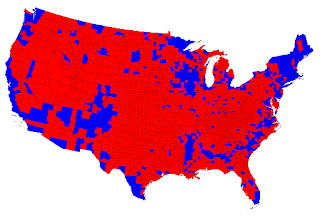 |
| Map of presidential vote outcome by party in 2012. |
... Sociologists could have a field day with this question, but the explanation could be something as simple as the fact that people who live in cities are relatively insulated from how difficult and challenging it can be to produce the food, energy, equipment, devices, etc., that comprise the affluence that urbanites enjoy. In their urban cocoons, city-dwellers take for granted the abundance and availability of the economic goods that they consume. For instance, many well-to-do, educated urbanites see no downside to supporting stricter regulations and higher taxes on energy producers, because to them, energy is something that is always there at the flip of a switch (except during the occasional hurricane, as some New Yorkers recently discovered). Life in the city for affluent Americans creates the illusion that all they have to do is demand something and—presto!—it will be there when they want it.A perfect encapsulation of what I've thought for years, read the whole thing.
Affluent denizens of our metropolises see no inconsistency in supporting the Democratic jihad against “greedy corporations” and “the rich” while also expecting their every whim to be supplied, often by those same corporations and successful entrepreneurs. This is because they are removed from some of the harsher daily realities of life that confront those who are on the front lines of mankind’s ongoing economic struggle. They have forgotten that mankind’s natural state is poverty and that strenuous, heroic efforts are required to produce the astounding affluence and abundant paraphernalia of our modern, affluent lifestyles. To use Marxian terminology, urbanites have become alienated from economic reality...
Incidentally, the "Red vs. Blue" distinction by color is relatively new. Up until the disputed election of 2000, the colors were not standardized by party from year to year, and even across different news outlets for the same election. Tim Russert is credited with inventing the terms "Red States" and Blue States in 2000. Until that point, blue was most often assigned to the Republicans:
Before the 2000 presidential election, the traditional color coding scheme was "Blue for Republican, Red for Democrat," in line with historical European associations (red was used for left-leaning parties). Traditional political mapmakers, at least throughout the 20th century, have used blue to represent the modern-day Republicans, and the Federalists who preceded them. Perhaps this was a holdover from the days of the Civil War when the predominantly Republican North was “Blue”. Even earlier, in the 1888 presidential election, Grover Cleveland and Benjamin Harrison used maps that coded blue for the Republicans, the color Cleveland perceived to represent the Union and "Lincoln's Party", and red for the Democrats. The parties themselves had no official colors, with candidates variously using either or both of the national color palette of red and blue (white being unsuitable for printed materials). Time magazine assigned red to the Democrats and blue to the Republicans in its election graphics in every election from 1988 to 2000. The Washington Post's election graphics for the 2000 election were Republican-blue, Democrat-red
No comments:
Post a Comment